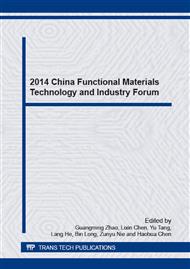p.218
p.222
p.231
p.237
p.243
p.248
p.252
p.258
p.264
Enhancement of Hydrophobility and Thermal Property of Graphene Oxide by Paratoluidine Chemical Functionalization
Abstract:
Graphene oxide (GO) is typically synthesized by graphite powder under strong oxidizing reaction, possessing with the same set of functional groups: epoxy and hydroxyl in basal plane and carboxyl and hydroxyl groups existence on the flake edges which endow GO with amphipathy. GO and its functionalized derivatives have been successfully tested in many domains, such as polymer composites, biosensors, drug delivery systems, etc. In this paper, GO was prepared by a modified Hummers method employing improved process (preparation and separation), aiming at industrialization with the lowest cost. Moreover, some novel functional groups with different properties were controlled chemically grafted onto GO to modify the wettability and reaction activity with other materials. The hydrophobicity and the thermal property of graphene oxide were enhanced by chemical functionalization.
Info:
Periodical:
Pages:
243-247
Citation:
Online since:
December 2014
Keywords:
Price:
Сopyright:
© 2015 Trans Tech Publications Ltd. All Rights Reserved
Share:
Citation:



